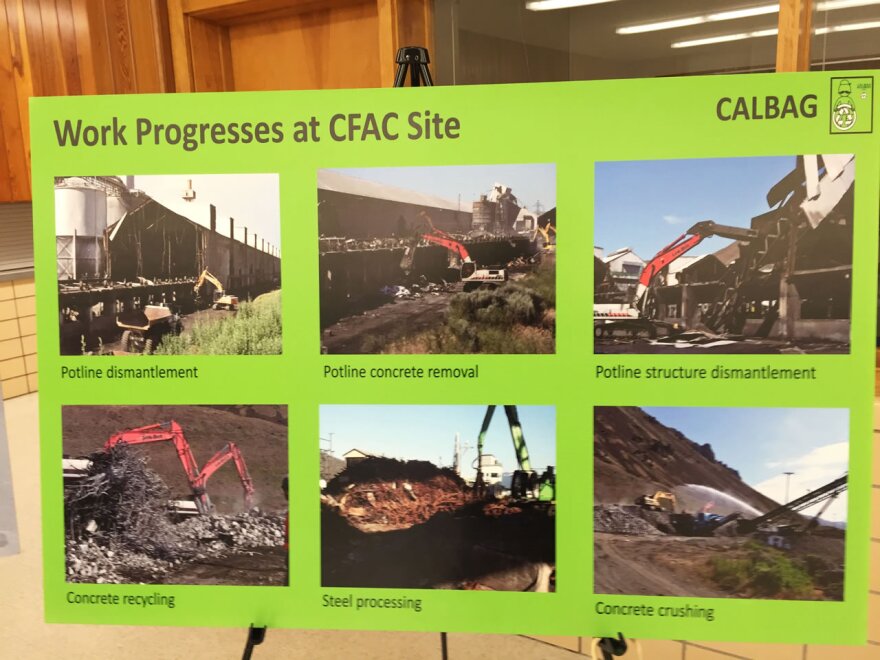The Columbia Falls Aluminum Company, or CFAC, closed its doors permanently this spring after the plant hadn’t fully operated since 2009.
Now, the company, private contractors, the Environmental Protection Agency and members of the community are talking about how to begin to cleaning up the old aluminum plant, where cyanide, fluoride and other metals have been detected in the soil.
Last night an arch of booths stretched around the Columbia Falls High School cafeteria, staffed by representatives of the agencies and companies involved in the discussions. They were there for anyone who wanted to stop by with questions or opinions about the cleanup process. A couple of dozen people came by.
The biggest question in the room was a dividing one - whether or not the CFAC site will be listed a Superfund.
Haley Beaudry works for CFAC.
"CFAC hopes we can work through this process and project without Superfund designation.”
Richard Smith is a local from Whitefish.
“Well, I wasn’t really sure what a Superfund site meant, and I talked with a lady over here and she says there are 30 people who aren’t really in favor of it.”
Mike Cirian works for the EPA.
“This does meet the priorities listing under our criteria and we’re recommending that it go to a Superfund site.”
Flathead County Commissioner Phillip Mitchell:
“I personally don’t like the connotation of a Superfund site. I think it is a determent to a community and some people don’t feel it’s a determinant. So we’ve got a diverse, I’m going to guess it's 50-50.”
Rod Childers worked for CFAC for 25 years.
“The only thing I learned is that they haven’t really started tearing it down yet. It’s in the investigation part and getting the paperwork part yet together so they can do it.”
It will take about five years for the environmental cleanup part to actually begin.
First, CFAC and the EPA hope to come to agreement on how to study the site by the end of this year. The goal is to gather information on how the site might impact human health and the environment, and options for future study.
Then, an environmental consulting company called Roux, who works for CFAC, will take hundreds of samples of soil, groundwater and sediment. Those samples will reveal the exact environmental condition of the landscape. It's estimated that studying the land’s environmental condition and creating an assessment of human risk will take about three years, pending approval from the EPA.
After that, Roux will write a plan for the physical clean up of the site.
Andrew Baris works for the consulting firm.
“I would say that this is a fairly aggressive schedule. As people who know, understand these investigations, sometimes they take longer, and they very rarely can get done much quicker than that. So this is a fairly aggressive schedule.”
The time it will take to even write a plan for the environmental rehab reflects one of the issues community members have with the site getting a Superfund listing.
Some fear giving greater authority to the EPA instead of CFAC will slow the process down because the agency has to review the paperwork before work can begin.
Others are worried about the stigma involved in having Superfund site in town.
But, regardless of whether CFAC is listed as a Superfund site, the EPA will have some involvement with the cleanup.
The EPA’s Mike Cirian says the Superfund stigma comes from a lack of knowledge about the designation.
“Nothing should change in Columbia falls. The drinking water doesn’t come from there. The site will be cleaner than it is now, so it will be better. Every Superfund site I’ve worked on, when we leave, property values are better than before we started.”
CFAC’s site has the properties of a Superfund site according to the EPA. The earliest it could be put on the Superfund list would be next spring.

Listing or not, CFAC and the EPA are working on a legal agreement covering the cleanup work, EPA’s oversight and potential for penalties if guidelines are not met.
Meanwhile, the physical plant of CFAC will be broken down. That will take about two and a half years. A company called Calbag Resources bought the building to demolish and use its tons of material as sellable recyclables.
A community liaison panel set up by CFAC holds meetings monthly to discuss the clean up. It includes community and agency members on all sides of this issue. Their next meeting is set for Thursday, November 12.


